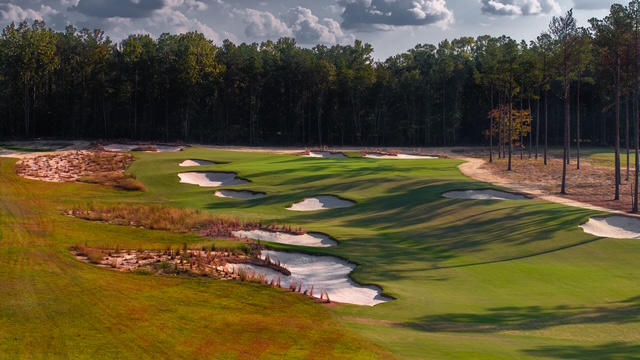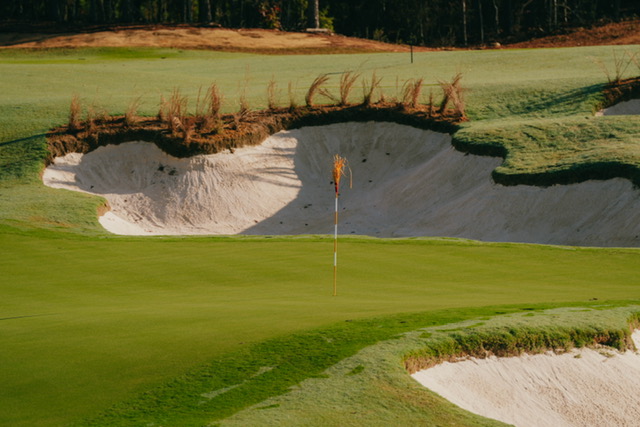
Broomsedge Golf Club was already one of the most anticipated openings in 2024, but when golfers began comparing its holes to iconic courses such as Pinehurst and Pine Valley the buzz became overwhelming.
So much so that the new Kyle Franz and Mike Koprowski layout outside of Columbia, South Carolina, had to shutter its limited outside play model until this fall. The course’s website will once again begin taking tee time requests this week after being closed to outside play for three months.
“When we have gotten different compliments — whether it’s a specific green site or a panorama view that may be reminiscent of some of these other places — it feels great because those are all courses that golfers revere,” says David McFarlin, one of Broomsedge’s founders and membership director.
McFarlin says a national membership costs $60,000 for an initiation fee, plus $6,000 per year for dues. The founders also have incorporated a model that many clubs in the United Kingdom and Ireland implement, allowing non-members limited outside access. The initial response in October 2024 was so humbling that Broomsedge was getting upwards of 80 inquiries a week for just six to eight tee times. For non-members, the green fee is $250.
“It was a very good thing in the golf world for us because it drove a lot of attention,” McFarlin says. “We believe the best golf courses in the world are meant to be played, and that’s something that we stand by. We allow non-members to play Broomsedge, but it’s on our terms.”

Broomsedge is located in Rembert, roughly 40 miles northeast of Columbia. For those more familiar with Interstate 95, the course is about 40 minutes west of I-95 just off Interstate 20.
“Our style of a national membership is to become a destination private golf club and cut out the destination part,” McFarlin says. “We provide that same type of feeling maybe that you get at some other courses from a standpoint of it being your own oasis completely detached and removed from everything. And while I love some of those other places where getting there is a journey and is really fun as a guest, but it may be a bit of a deterrent as a member.
“So we provide the exact same boutique destination oasis, but at the end of the day, we’re not two planes and then a four-hour drive for most of our national members, especially coming from the Midwest and the Northeast. They have direct flights to Columbia and you can land and be on the first tee at Broomsedge in 45 minutes. That’s a radically different value proposition than maybe some of the others in our category of a private destination.”
It appears the Sandhills of South Carolina was long overdue for a course of this stature, according to Franz.
“It was something of an oddity to me that there were some really good golf courses around Columbia, but no truly great, top-100 ranked one considering Donald Ross worked down the road at Camden Country Club,” says Franz, who has accomplished award-winning restoration work on numerous Ross layouts over the last decade, including Pinehurst No. 2 and Pine Needles.
“Columbia is somewhat notorious for not having architecturally significant golf in a state that is otherwise flooded with it,” adds McFarlin. “We don’t need to name all the top 100 golf courses that stretch down the entire Low Country to Savannah, so yeah, bringing something wonderful to the greater Columbia area was important to us. This stretch of the Sandhills is uniquely qualified for great golf but was otherwise untapped.”
The course is situated on just 156 acres and is blessed with unusually dramatic elevation changes for a property that also includes valleys, ridgelines and chasms — and of course an abundance of broomsedge. The native vegetation is a hearty grass that grows in loose sandy soils and provides seasonal interest, transitioning from green in warmer months to a striking golden-orange during the colder seasons.

Broomsedge features a flexible design that includes 20 green sites for 18 holes, enabling alternative and shared greens throughout the course. Franz and his team also incorporated property boundaries into lines of play that are reminiscent of courses built more than a century ago, creating some unique strategies.
“I always kind of joke that this place is like a golfer’s playground because yes, you can play our championship routing of the 18 holes that we love, but at the same time you can let your imagination kind of go wild on all these other fun holes,” says director of golf Trevor Murphy.
“We’re trying to give people who are going to be on site for two to three straight days a feel like they’re playing something a little bit different, some real variation to the core setup,” McFarlin says.
He said the double greens are not gimmicks.
“From a true architecture standpoint you don’t want to build those additional greens unless you have two compelling cases and we did,” he says. “We didn’t ever want to build something where there was an A and a B, or a first choice and a second choice. It just gives the course some elasticity.”
As of now there is no lodging, but there are teams have plans on the books to build some, along with a potential second 18 holes across the street from Broomsedge.
“Let’s just say 2026 is going to be a big year for us in terms of verticals — cottages, clubhouse planning — all the other things that are going to allow the grooming and growing of the club over the coming years,” McFarlin says.
The course was one of the first built from scratch by Franz, who previously cut his teeth under such high-profile architects as Bill Coore and Ben Crenshaw, Tom Doak and Gil Hanse.
“I thought between it being an SEC and university town, a state capital and had a Sandhills type of feel to it that it was a great idea to look at a potential piece of land there,” Franz says. “And Mike believed the property might be one of the best on the books. In the end all the pieces came together beautifully.”
